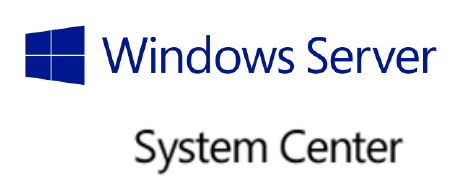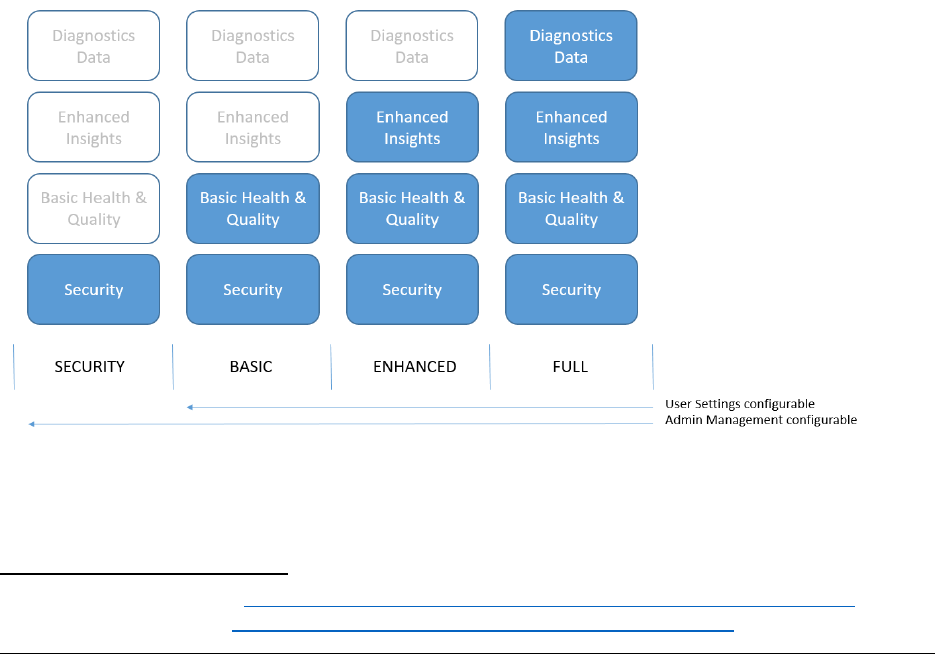
WINDOWS SERVER 2016 AND SYSTEM
CENTER 2016 TELEMETRY
Technical Overview White Paper
May, 2016
Applies to Windows Server 2016 Technical Preview

Contents
Summary ....................................................................................................................................................... 1
Overview ....................................................................................................................................................... 1
How does Microsoft protect the security of the data? ................................................................................ 2
Data collection .......................................................................................................................................... 2
Data transmission ..................................................................................................................................... 2
Data use and access .................................................................................................................................. 3
Data retention ........................................................................................................................................... 3
What data is gathered at different telemetry levels? .................................................................................. 3
Security level ............................................................................................................................................. 4
Basic level .................................................................................................................................................. 5
Enhanced level .......................................................................................................................................... 6
Full level .................................................................................................................................................... 6
How can enterprises manage telemetry collection? .................................................................................... 7
Configure the operating system telemetry level ...................................................................................... 7
Use Group Policy to set the telemetry level ......................................................................................... 7
Use MDM to set the telemetry level .................................................................................................... 8
Turn off telemetry collection in System Center 2016 for the enterprise ................................................. 8
Additional telemetry controls ................................................................................................................... 8
Examples of how Microsoft uses the telemetry data ................................................................................... 9
Drive higher apps and driver quality in the ecosystem ............................................................................ 9
Reduce your total cost of ownership and downtime ............................................................................... 9
Build features that address our customers’ needs ................................................................................... 9

Page 1
Windows Server 2016 and System
Center 2016 Telemetry
Microsoft Corporation
Summary
This document provides our server and enterprise customers with the necessary information to make
informed decisions about how to configure telemetry in their environments. It discusses telemetry as
system data that is uploaded by the Connected User Experience and Telemetry component. In this
document we will focus on the telemetry data from Windows Server 2016 and System Center 2016.
We will discuss how we use it to troubleshoot problems and improve our products and services. There
will also be some references to Windows 10 because the underlying infrastructure in Windows Server is
the same.
Note This whitepaper does not apply to System Center Configuration Manager, System Center Endpoint
Protection, or System Center Data Protection Manager because those components use a different
telemetry service from Windows and Windows Server.
It describes the steps that Microsoft takes to help protect the security and privacy of our customers’
data, the types of telemetry we gather, and the ways an enterprise can manage its telemetry. The
document also lists some examples of how telemetry can provide you with valuable insights into your
enterprise deployments, and how Microsoft uses the data to quickly identify and address issues that
affect its customers.
We understand that the privacy and security of our customers’ information is very important. We have
taken a thoughtful and comprehensive approach to customer privacy and the protection of customer
data with Windows, Windows Server, and System Center. IT administrators have controls to customize
features and privacy settings at any time. Our commitment to transparency and trust is clear:
• We are open with customers about the types of data we gather.
• We put enterprise customers in control—they can customize their own privacy settings.
• We put customer privacy and security first.
• We are transparent about how telemetry gets used.
• We use telemetry to improve customer experiences.
Overview
In previous versions of Windows and Windows Server, Microsoft used telemetry to check for updated or
new Windows Defender signatures, check whether Windows Update installations were successful,
gather reliability information through the Reliability Analysis Component (RAC) on Windows Server, and
gather reliability information through the Windows Customer Experience Improvement Program (CEIP)
on Windows. In Windows 10 and Windows Server 2016 Technical Preview, you can control telemetry
streams by using Settings > Privacy, Group Policy, or Mobile Device Management (MDM).
Microsoft is committed to improving customer experiences in a mobile-first and cloud-first world, and it
all starts with our customers. Telemetry is one critical way Microsoft is using data to improve our
products and services. Telemetry gives every enterprise customer a voice that helps us shape future
versions of Windows, Windows Server, and System Center. This allows us to respond quickly to your
feedback, and provide new features and improved quality to our customers.

Page 2
Windows Server 2016 and System
Center 2016 Telemetry
Microsoft Corporation
Our goal is to leverage the aggregated data to drive changes in the product and ecosystem to improve
our customer experiences. We are also partnering with enterprises to provide added value from the
telemetry information that is shared by their devices. Some examples include identifying outdated
patches and downloading the latest antimalware signatures to help keep their devices secure,
identifying application compatibility issues prior to upgrades, and gaining insights into driver reliability
issues affecting other customers.
How does Microsoft protect the security of the data?
Data collection
Windows 10 and Windows Server 2016 include the Connected User Experience and Telemetry
component, which uses the Event Tracing for Windows (ETW) trace logging
1
technology to gather and
store telemetry events and data. The operating system and some Microsoft management solutions like
System Center use the same logging technology.
1. Operating system features and some management applications are instrumented to publish
events and data. Examples of management applications include Virtual Machine Manager
(VMM), Server Manager, and Storage Spaces.
2. Events are gathered by using public operating system event logging and tracing APIs.
3. You can configure the telemetry level by using an MDM policy, Group Policy, or registry settings.
4. The Connected User Experience and Telemetry component transmits telemetry data over HTTPS
to Microsoft and uses certificate pinning.
Data transmission
All telemetry data is encrypted using SSL and uses certificate pinning during transfer from the device to
Microsoft.
Endpoints
The Microsoft Data Management service routes data back to our protected cloud storage. Only
Microsoft personnel with a valid business justification are permitted access.
The Connected User Experience and Telemetry component connects to the Microsoft Data Management
service at v10.vortex-win.data.microsoft.com.
The Connected User Experience and Telemetry component also connects to settings-
win.data.microsoft.com to download configuration information.
Windows Error Reporting
connects to watson.telemetry.microsoft.com.
Online Crash Analysis connects to oca.telemetry.microsoft.com.
1
About TraceLogging - https://msdn.microsoft.com/en-us/library/dn904632(v=vs.85).aspx

Page 3
Windows Server 2016 and System
Center 2016 Telemetry
Microsoft Corporation
Data use and access
Data gathered from telemetry is used by Microsoft teams primarily to improve our customer
experiences, and for security, health, quality, and performance analysis. The principle of least privileged
guides access to telemetry data. Only Microsoft personnel with a valid business need are permitted
access to the telemetry data. Microsoft does not share personal data of our customers with third
parties, except at the customer’s discretion or for the limited purposes described in the Privacy
Statement
2
. We do share business reports with OEMs and third party partners that include aggregated,
anonymized telemetry information. Data sharing decisions are made by an internal team including
privacy, legal, and data management.
Data retention
Microsoft believes in and practices information minimization. We strive to gather only the information
that we need, and we store it for as long as it’s needed to provide a service or for analysis. Much of the
information about how the operating system and apps are functioning is deleted within 30 days. Other
information, such as error reporting data, may be retained longer.
What data is gathered at different telemetry levels?
This section illustrates and explains the different telemetry levels in Windows 10 and Windows Server
2016. These levels are available on all editions of Windows Server 2016. The following figure shows a
comparison of the telemetry levels:
The telemetry levels are cumulative and can be categorized into four levels:
2
Windows Server prerelease: http://windows.microsoft.com/en-us/windows/preview-privacy-statement
System Center prerelease: http://go.microsoft.com/fwlink/?LinkID=623851&clcid=0x409

Page 4
Windows Server 2016 and System
Center 2016 Telemetry
Microsoft Corporation
• Security: Information that’s required to help keep the OS and System Center secure, including
data about the Connected User Experience and Telemetry component settings, the Malicious
Software Removal Tool (MSRT), and Windows Defender.
• Basic: Basic device information, including: quality-related data, app compatibility, app usage
data, and data from the Security level.
• Enhanced: Additional insights, including: how the OS, System Center, and apps are used, how
they perform, advanced reliability data, and data from both the Basic and Security levels.
• Full: All data necessary to identify and help to fix problems, plus data from the Security, Basic,
and Enhanced levels.
Security level
The Security level gathers only the telemetry data that is required to keep Windows devices, Windows
Server, and guests secure with the latest security updates. This level is available on all Windows Server
2016 editions and only on Windows 10 Enterprise, Windows 10 Education, Windows 10 Mobile
Enterprise, and IoT Core editions.
Note: If your organization relies on Windows Update for updates, you shouldn’t use the Security level.
Because no Windows Update information is gathered at this level, important information about update
failures is not sent. Microsoft uses this information to fix the causes of those failures and improve the
quality of our updates.
Windows Server Update Services (WSUS) and System Center Configuration Manager functionality is not
affected at this level, nor is telemetry data about Windows Server features or System Center gathered.
The data gathered at this level includes:
• Connected User Experience and Telemetry component settings: If data has been gathered and
is queued to be sent, the Connected User Experience and Telemetry component downloads its
settings file from Microsoft servers. The data gathered by the client for this request includes OS
information, device id (used to identify what specific device is requesting settings) and device
class (for example, whether the device is server or desktop).
• Malicious Software Removal Tool (MSRT): The MSRT infection report contains information
such as device information and IP address.
Note: You can turn off the MSRT
3
infection report. No MSRT information is included if MSRT is
not used. If Windows Update is turned off, MSRT will not be offered to users.
• Windows Defender/Endpoint Protection: Windows Defender and System Center Endpoint
Protection require some information to function, including: anti-malware signatures, diagnostic
information, User Account Control settings, Unified Extensible Firmware Interface (UEFI)
settings, and IP address.
Note: This reporting can be turned off and no information is included if a customer is using
third-party antimalware software, or if Windows Defender is turned off.
3
About MSRT: http://support.microsoft.com/en-us/kb/890830

Page 5
Windows Server 2016 and System
Center 2016 Telemetry
Microsoft Corporation
Microsoft recommends that Windows Update, Windows Defender, and MSRT remain enabled
unless the enterprise uses alternative solutions such as WSUS, System Center Configuration
Manager, or a third party antimalware solution. Windows Update, Windows Defender, and
MSRT provide core Windows functionality such as driver and OS updates, including security
updates.
For servers with default telemetry settings and no Internet connectivity, you should set the telemetry
level to Security. This stops data gathering for events that would not be uploaded due to the lack of
Internet connectivity.
No user content, such as user files or communications, is gathered at the Security telemetry level, and
we avoid gathering any information that directly identifies a company or user, such as a name or email
address. However, in rare circumstances, MSRT information may unintentionally contain personal
information. For instance, some malware may create entries in a computer’s registry that include
information such as a username, which would cause it to be gathered. MSRT reporting is optional and
can be turned off at any time.
Basic level
The Basic level gathers a limited set of data that is critical for understanding the system and its
configuration. This level includes the Security level information. This level helps to identify problems
that can occur on a particular device hardware or software configuration. For example, it can help
determine if crashes are more frequent on devices with a specific amount of memory or a particular
network driver version. The Connected User Experience and Telemetry component does not gather
telemetry data about System Center, but it can transmit telemetry for non-Windows apps if they have
user consent.
The data gathered at this level includes:
• Basic device information: Helps provide an understanding about the types and configurations of
native and virtualized Windows Server 2016 instances in the ecosystem, including:
o Machine attributes, such as the OEM, model, and BIOS date
o Networking attributes, such as the number and speed of network adapters
o Processor and memory attributes, such as the number of cores, architecture, memory
size, and firmware version
o Virtualization attributes, such as Second Level Address Translation (SLAT) support and
the guest operating system
o OS attributes, such as the edition and virtualization state
o Storage attributes, such as the number of drives, type, speed, and size
• Connected User Experience and Telemetry component quality metrics: Helps provide an
understanding about how the Connected User Experience and Telemetry component is
functioning, including percent of uploaded events, dropped events, and the last upload time.
• Quality-related information: Helps Microsoft develop a basic understanding of how a device
and its operating system are performing. An example is the count of crashes in the operating
system on a particular hardware configuration or with a specific driver version.

Page 6
Windows Server 2016 and System
Center 2016 Telemetry
Microsoft Corporation
• Compatibility data: Helps provide an understanding about which apps are installed on a system
and virtual machine, and identifies potential compatibility problems.
o General app data: Includes a list of apps that are installed on a native or virtualized
instance of the OS and whether these apps function correctly after an upgrade. This app
data includes the app name, publisher, version, and basic details about which files have
been blocked from usage.
o App usage data: Includes how an app is used, including how long an app is used for,
when the app has focus, and when the app is started.
o System data: Helps provide an understanding about whether a system meets the
minimum requirements to upgrade to the next OS version. System information includes
the amount of memory, as well as information about the processor and BIOS.
o Accessory device data: Includes a list of accessory devices, such as external storage
devices, that are connected to Windows systems and whether these devices will
function after upgrading to a new version of the OS.
o Driver data: Includes specific driver usage that is meant to help figure out whether apps
and systems will function after upgrading to a new version of the OS. This data can help
determine blocking issues and then help Microsoft and our partners apply fixes and
improvements.
Enhanced level
The Enhanced level gathers data about how the OS and apps are used and how they perform. This level
also includes data from the Security and Basic levels. This level helps to improve the user experience
with the OS and apps. Data from this level can be abstracted into patterns and trends that can help
Microsoft determine future development improvements.
This is the default level on all Windows Server 2016 and System Center 2016 editions. It is the minimum
level that is required to quickly identify and address OS and System Center customer quality issues.
The data gathered at this level includes:
• OS events: Help to gain insights into different areas of the OS, including networking, Hyper-V,
storage, file system, and other components.
• OS app events: Result from Microsoft applications and management tools that were installed
with or on Windows Server (for example, Server Manager and System Center).
• Some crash dump types. All crash dump types, except for heap dumps and full dumps.
Full level
The Full level gathers data necessary to identify and help fix problems. This level also includes data from
the Security, Basic, and Enhanced levels.
If systems experience problems that are difficult to identify or repeat using Microsoft’s internal testing,
additional data becomes necessary. This data can include any user content that might have triggered
the problem. It is gathered from a small randomly selected set of systems that have both opted into the
Full telemetry level and have exhibited the problem. Data sharing decisions are made by an internal
team including privacy, legal, and data management.

Page 7
Windows Server 2016 and System
Center 2016 Telemetry
Microsoft Corporation
How can enterprises manage telemetry collection?
We do not recommend that you turn off telemetry in your organization because valuable functionality
may be impacted, but we recognize that in some scenarios this may be required. Use the steps in this
section to turn off telemetry for Windows 10, Windows Server 2016, and System Center 2016.
Important: These telemetry levels only apply to Windows, Windows Server, System Center
components, and apps that use the Connected User Experience and Telemetry component. Non-
Windows components, such as Microsoft Office or other third-party apps, may communicate with their
cloud services outside of these telemetry levels. You should work with your app vendors to understand
their telemetry policy, and how you can opt in or opt out. For more information on how Microsoft Office
uses telemetry, see Overview of Office Telemetry
4
.
Customers can turn off System Center telemetry collection. The default is on at the Enhanced level. The
data gathered at this level represents what is collected by default when System Center telemetry is
turned on. However, setting the operating system telemetry level to Basic turns off System Center
telemetry, even if the System Center telemetry switch is turned on.
The lowest telemetry setting level that is supported on Windows Server 2016 through management
policies is Security. The lowest telemetry setting that is supported through the Settings UI is Basic. The
default telemetry level for all Windows Server 2016 editions is Enhanced.
Configure the operating system telemetry level
You can configure your OS telemetry settings using the management tools you are already using, such as
Group Policy, MDM, or Windows Provisioning. You can also manually change your settings using Registry
Editor. Setting your telemetry levels through a management policy overrides any device level settings.
Use the appropriate value in the following table when you configure the management policy.
Value
Level
Data gathered
0
Security
Security data only.
1
Basic
Security data, and Basic Health and Quality data.
2
Enhanced
Security data, Basic Health and Quality data, and Enhanced Insights.
3
Full
Security data, Basic Health and Quality data, Enhanced Insights and
Advanced Reliability data, and Diagnostics data.
Table 1: Telemetry levels and data types
Use Group Policy to set the telemetry level
Use a Group Policy object to set your organization’s telemetry level.
1. From the Group Policy Management Console, go to Computer Configuration > Administrative
Templates > Windows Components > Data Collection and Preview Builds.
4
Overview of Office Telemetry: https://technet.microsoft.com/library/jj863580.aspx

Page 8
Windows Server 2016 and System
Center 2016 Telemetry
Microsoft Corporation
2. Double-click Allow Telemetry.
3. In the Options box, select the level that you want to configure, and then click OK.
Use MDM to set the telemetry level
Use the Policy Configuration Service Provider (CSP)
5
to apply the System/AllowTelemetry MDM policy.
Use Registry Editor to set the telemetry level
Use Registry Editor to manually set the registry level on each device in your organization, or write a
script to edit the registry. If a management policy already exists, such as Group Policy or MDM, it will
override this registry setting.
1. Open Registry Editor, and go to
HKEY_LOCAL_MACHINE\Software\Microsoft\Windows\CurrentVersion\Policies\DataCollection.
2. Right-click DataCollection, click New, and then click DWORD (32-bit) value.
3. Type AllowTelemetry, and then press ENTER.
4. Double-click AllowTelemetry and set the desired value from the table above, and then click OK.
5. Click File > Export, and then save the file as a .reg file, such as C:\AllowTelemetry.reg. You can
run this file from a script on each device or virtual machine (VM) in your organization.
Turn off telemetry collection in System Center 2016 for the enterprise
For System Center 2016 Technical Preview 4, IT administrators can reduce the flow of System Center
telemetry to zero by following these steps:
• Turn off telemetry by going into the System Center UI Console settings workspace.
• For Service Management Automation and Service Provider Foundation instructions on how to
turn off telemetry, see Microsoft Knowledge Base article# 3096505
6
.
Additional telemetry controls
In Windows Server 2016, there are additional telemetry controls to reduce the flow of Windows
telemetry data:
• Change the default telemetry level from Enhanced to Security.
• Turn off Windows Update, or set the machines to be managed by an on premise update server
such as WSUS
7
or System Center Configuration Manager
8
.
• Turn off Windows Defender Cloud based Protection and Automatic sample submission in
Settings > Update & Security > Windows Defender. If a third-party antimalware service is
installed, Windows Defender (and its telemetry) should automatically shut off.
5
Configuration Service Provider: https://msdn.microsoft.com/library/windows/hardware/dn904962(v=vs.85).aspx
6
Microsoft KB: 3096505 How to disable telemetry for Service Management Automation and Service Provider
Foundation (https://support.microsoft.com/en-us/kb/3096505)
7
About Windows Server Update Services (WSUS): https://technet.microsoft.com/library/hh852345.aspx
8
System Center Configuration Manager: https://technet.microsoft.com/en-us/library/dn965439.aspx

Page 9
Windows Server 2016 and System
Center 2016 Telemetry
Microsoft Corporation
• Turn off the MSRT infection report as described in the Microsoft Knowledge Base article
“Deployment of the Microsoft Windows Malicious Software Removal Tool in an enterprise
environment.”
9
Note: Microsoft does not intend to gather sensitive information, such as credit card numbers,
usernames and passwords, email addresses, or other similarly sensitive information. We guard against
such events by using technologies to identify and remove sensitive information before it is sent from the
user's device. If we determine that sensitive information has been inadvertently received, we delete it.
Examples of how Microsoft uses the telemetry data
Drive higher apps and driver quality in the ecosystem
Telemetry plays an important role in helping us quickly identify and fix critical reliability and security
issues in our customers’ deployments and configurations. Insights into the telemetry data that we
gather help us quickly identify crashes or hangs associated with a certain application or driver on a given
configuration, like a particular storage type (for example, SCSI) or a memory size.
For System Center, job usages and statuses can also help us enhance the job workload and the
communication between System Center and its managed products. Microsoft’s ability to get this data
from customers and drive improvements into the ecosystem helps raise the bar for the quality of System
Center, Windows Server applications, Windows apps, and drivers. Real-time data about Windows Server
and Windows installations reduces downtime and the cost associated with troubleshooting unreliable
drivers or unstable applications
Reduce your total cost of ownership and downtime
Telemetry provides a view of which features and services customers use most. For example, the
telemetry data provides us with a heat map of the most commonly deployed Windows Server roles,
most used Windows features, and which ones are used the least. This helps us make informed decisions
about where we should invest our engineering resources to build a leaner operating system.
For System Center, understanding the customer environment for management and monitoring will help
drive the support compatibilities matrix, such as host and guest OS. This can help you use existing
hardware to meet your business needs and reduce your total cost of ownership. It can also help to
reduce the downtime that is associated with security updates.
Build features that address our customers’ needs
Telemetry also helps Microsoft to better understand how customers deploy components, use features,
and use services to achieve their business goals. Getting insights from that data helps us prioritize our
engineering investments in areas that can directly impact our customers’ experiences and workloads.
Some examples include customer usage of containers, storage, and networking configurations that are
associated with Windows Server roles like Clustering and Web. Another example is to find out when CPU
hyper-threading is turned off and what the resulting impact is. We use the insights to drive
9
Microsoft KB: 891716 Deployment of the Microsoft Windows Malicious Software Removal Tool in an enterprise
environment. (http://support.microsoft.com/kb/891716/)

Page 10
Windows Server 2016 and System
Center 2016 Telemetry
Microsoft Corporation
improvements and intelligence into some of our management and monitoring solutions. This helps
customers to diagnose quality issues and save money by making fewer support calls to Microsoft.
